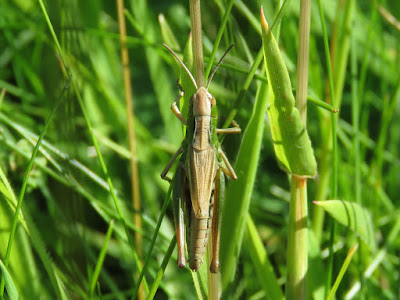It was a dark, cold and drizzly morning at times at North Cave Wetlands, which will be obvious from the quality of the selection of photos in the post. Just after leaving the car it was obvious a large flock of greylag geese had just landed in the reserve, their calls still nervous and loud, maybe family groups reuniting after being separated and the members of the flock assessing the situation. From the viewing platform, I could watch the flock, probably numbering over a thousand individuals, slowly calming down. I scanned the flock for other species or unusual individuals. The Black Swan that often visits the site was with the them, and also at least three GreylagxCanada hybrids. I couldn't see other species, but there was an unusual leucistic individual. There were many Lapwings and Little Grebes today, I don't think I've ever seen so many of the latter in the reserve. A few Wigeon and many teal too.
Swallows, House Martins and Sand Martins flew about, reminding me that we are in migration season and they soon will be gone.
In Island Lake there were many Snipe, scattered about, Shoveler and more Lapwing. I walked on the path by maize field by the road, where i came across a few fairy circles made from fungi growing on the grass making a circular pattern. On the large patch of rosebay willowherb, a few Reed Bunting played hide and seek, although in general they were quite curious and let me approach quite closely (top shot).
The couple of unexpected wintry surprises were a Short-eared owl, a species I hadn't seen in many years, flying high over the fields north of the reserve. I didn't have very long views as the hawthorn hedge got in the way, but its large head and long broad wings were very apparent. I only managed a very poor blurry shot. Then while watching a mixed flock of Long-tailed, Blue and Great Tits I heard siskin calls and there they were. The Siskins at the same time that a Migrant Hawker hung from the same alder tree was something I don't see every day either.
From Crosslands hide I watched four Little Egrets feeding, a distant Greenshank and a Ruff. There was not much else.
One of the highlights was finding an Elephant Moth Caterpillar on rosebay willowherb by the Butterfly Path, they are fantastic beasts. The rain then started to pick up, reminding me that it was time to go home for a warm lunch.
Leucistic greylag
Black Swan
CanadaxGreylag hybrid
Grey Heron
Two Snipe and sleeping Teal at Island Lake
Kentish Snail crossing spider web
Fairy ring by maize field
Record shot of Migrant Hawker resting on alder, surprisingly given the weather, it was flying about a few moments earlier.
Siskins about to fly to the alders by the north path
One of three very quiet Chiffchaffs
An extremely poor shot of a Short-eared Owl flying over fields N of the reserve
Ruff
One of four Little Egrets
This large Elephant Hawkmoth caterpillar sat quite exposed on Rosebay Willowherb
Resting Sand Martins
Meadow Pipit
For today's bird list click
here.





























































